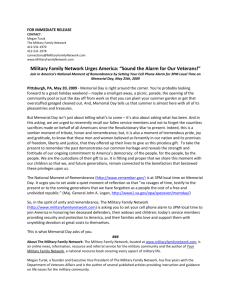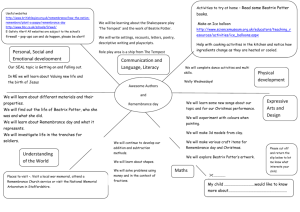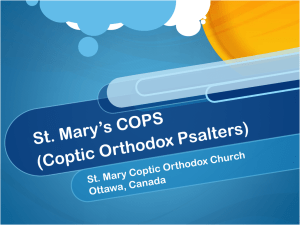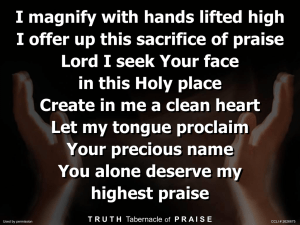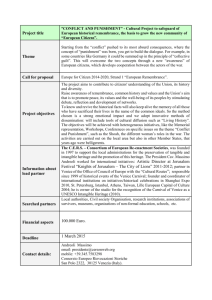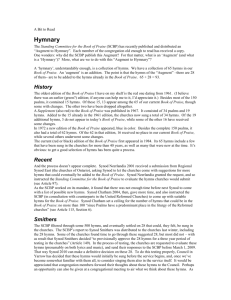liturgical aspects
advertisement
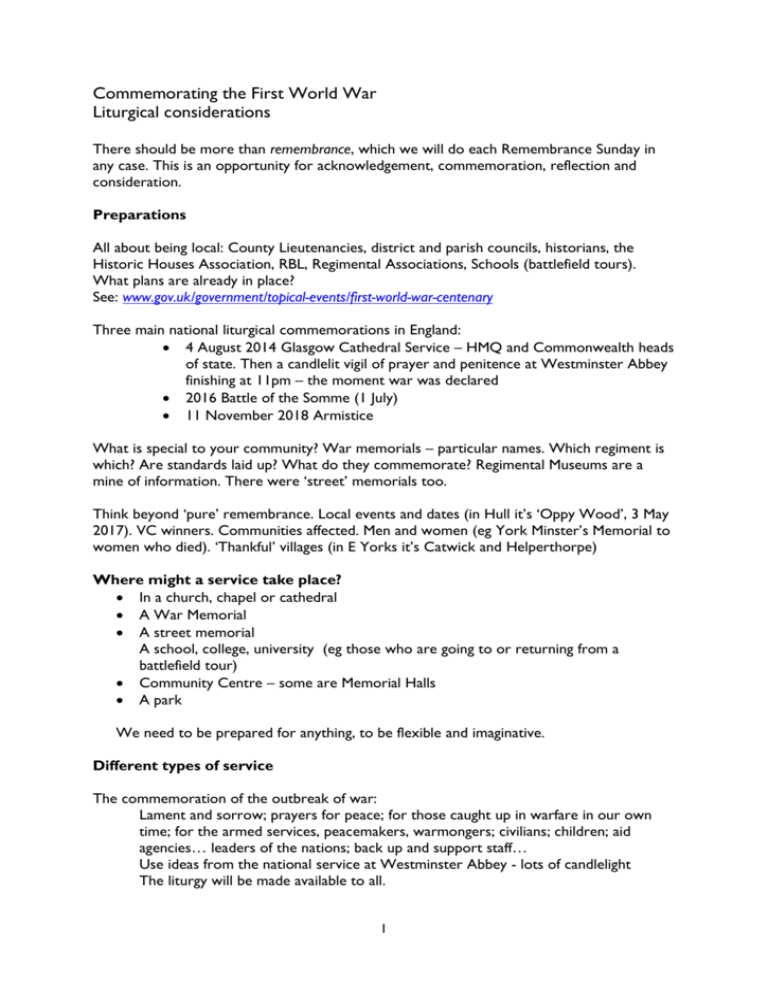
Commemorating the First World War Liturgical considerations There should be more than remembrance, which we will do each Remembrance Sunday in any case. This is an opportunity for acknowledgement, commemoration, reflection and consideration. Preparations All about being local: County Lieutenancies, district and parish councils, historians, the Historic Houses Association, RBL, Regimental Associations, Schools (battlefield tours). What plans are already in place? See: www.gov.uk/government/topical-events/first-world-war-centenary Three main national liturgical commemorations in England: 4 August 2014 Glasgow Cathedral Service – HMQ and Commonwealth heads of state. Then a candlelit vigil of prayer and penitence at Westminster Abbey finishing at 11pm – the moment war was declared 2016 Battle of the Somme (1 July) 11 November 2018 Armistice What is special to your community? War memorials – particular names. Which regiment is which? Are standards laid up? What do they commemorate? Regimental Museums are a mine of information. There were ‘street’ memorials too. Think beyond ‘pure’ remembrance. Local events and dates (in Hull it’s ‘Oppy Wood’, 3 May 2017). VC winners. Communities affected. Men and women (eg York Minster’s Memorial to women who died). ‘Thankful’ villages (in E Yorks it’s Catwick and Helperthorpe) Where might a service take place? In a church, chapel or cathedral A War Memorial A street memorial A school, college, university (eg those who are going to or returning from a battlefield tour) Community Centre – some are Memorial Halls A park We need to be prepared for anything, to be flexible and imaginative. Different types of service The commemoration of the outbreak of war: Lament and sorrow; prayers for peace; for those caught up in warfare in our own time; for the armed services, peacemakers, warmongers; civilians; children; aid agencies… leaders of the nations; back up and support staff… Use ideas from the national service at Westminster Abbey - lots of candlelight The liturgy will be made available to all. 1 Significant anniversaries eg Battle of the Somme, and local commemorations. The Thankful Villages http://www.bbc.co.uk/news/magazine-15671943 And thankfulness for all those who returned. Armed Forces Days Local World War 1 Memorial – esp those where people fell together Armistice Day 2018 Thanksgiving – heartfelt for the end of WW1; with lament for continuing strife and enmity; Act of commitment to a peaceful future… The shape of the service The Liturgical Commission will be producing a range of official liturgical resources And…something that is tailor-made to your own situation. Some examples of shape: A Service of the Word A simple shape eg those in They shall Grow not Old and A narrative shape eg example of the QE11 Accession service. Holy Communion – where to put the additional bits? Processional and Stational – different memorials in a parish or community. Will you include an Act of Remembrance every time? Discuss… Use of sound /drama/visuals The Manchester Blitz - a dramatic opening – hiring props, such as a working WW11 air-raid siren, sandbags, gas masks, verger dressed as air-raid warden outfit - buying a CD from the Imperial War Museum north (sounds and music) 60th Anniversary of the Accession of Queen Elizabeth 11 – the radio announcement of the death of King George V1 was in the BBC archives (14 November 1922 – launch of British Broadcasting Company [later a Corporation] – first on the air, so this option not available for WW1 – but silent films clips are) - we then took people on a journey, through the funeral of King George V1 (using some of the funeral music), - then focus on the young Queen, when the narrative beings, three or four sections of narrative, giving shape and structure to the other liturgical elements. 2 Examples of symbol Candles – almost always very effective… Poppies, of course Veteran Cars / vintage aircraft/Re-enactment Groups Resources Books – see my book list. Lots of resources in these for liturgy, readings, hymns, prayers, symbolic action… Hymns Psalm-based (useful for services when others are from faith groups who regard the psalms as sacred texts) eg from New English Hymnal 334 366 397 417 427 433 436 437 457 459 467 All people that on earth do dwell (Ps 100) God of mercy, God of grace (Ps 67) Let us, with a gladsome mind (Ps 136) O God, our help in ages past (Ps 90) O praise ye the Lord (Ps150) O Worship the King (Ps 104) Praise my soul, the King of heaven (Ps 103) Praise the Lord! Ye heavens adore him (Ps 148) The King of love my shepherd is (Ps 23) The Lord’s my shepherd (Ps 23) Through all the changing scenes of life (Ps 34) English Hymnal was published in 1906 – we could choose some hymns that are contemporary with WW1. Lament (Wild Goose are good at this…) We cannot measure how you heal (Common Praise 348) What shall we pray? (In Beyond our Tears and Common Ground) We lay our broken sorrow (in Common Ground) Timothy Dudley Smith Eternal God, before whose face we stand (written especially for Remembrance) this is in Sing Praise (149) and House of Praise (OUP/Hope 2003) Also in House of Praise Behold a broken World Remember, Lord, the Word you made Other hymns and songs suitable for Acts of Remembrance – see lists in the recommended books, hymns, songs, Taize… - also see the RSCM’s list of hymns for Remembrance at http://www.rscm.com/assets/publications/sbys/Remembrance_Oct12.pdf 3 Music (Choral, instrumental) Several well-known English composers were contemporary, eg Sir Charles Hubert Hastings Parry (1848-1918) Sir Edward Elgar (1857-1934) Enigma Variations 1899 First of the Pomp and Circumstance Marches 1901 Charles Villiers Stanford (1852-1924) John Ireland (1879-1963) Greater love hath no man Ralph Vaughan Williams (1872-1958) RVW had significant WWI experience – see his Wikipedia entry Gustav Holst (1874-1934) Sought to enlist was deemed unfit. Composed significant works during WWI (inc The Planets) See suggested anthems and music by the RSCM for Remembrance at http://www.rscm.com/assets/publications/sbys/Remembrance_Oct12.pdf Poems There are loads a poetry books available (there should be a booklist list from Aidan Platten) – and poetry can be very effective: Printed in the front cover of an order of service; Read out in the service. Diaries WW1 Songs and Music Silent film of the War The Coventry Litany of Reconciliation – excellent with or without music Written after WW11 – but a very appropriate piece of liturgy to use in these contexts. Can be said responsively or sung by a choir. (Music from Coventry Cathedral – hauntingly beautiful and moving.) Bible Readings Some practical considerations Who to involve? – eg other faith groups, descendants of servicemen etc Standards, Colours and Banners – will be a focus for Beverley! Bugler – always check!. Seating plan required? Who will be your honoured guests? 4
